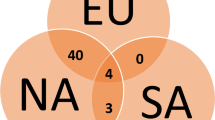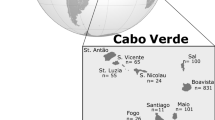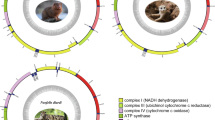Abstract
The genus Hegeter comprises 23 species of darkling beetles (Tenebrionidae) endemic to the Macaronesian archipelagos, with 21 of them exclusive to the Canary Islands. We have sequenced 438 bp of the mitochondrial Cytochrome Oxidase I gene in 17 species (24 taxa) of Canarian Hegeter. Estimates of nucleotide composition, transition/transversion ratios and nucleotide change frequencies are very similar to those found in another tenebrionid Canarian genus Pimelia, indicating that similar molecular mechanisms are driving the sequence evolution. The sequence variation found allows phylogenetic analyses of the genus and the deduction of colonization patterns. These involve sequential island invasion with more rapid establishment and radiation than found in the related beetles of the genus Pimelia.
Similar content being viewed by others
Article PDF
References
Ancochea, E, Fuster, J M, Ibarrola, E, et al., 1990. Volcanic evolution of the island of Tenerife (Canary Islands) in the light of new K-Ar data. J Volcanol Geotherm Res, 44, 231–249.
Anguita, F, and Hernan, F. 1975. A propagating fracture model versus a hot spot origin for the Canary Islands. Earth Planet Sci Lett, 27, 11–19.
Barrio, E, Latorre, A, and Moya, A. 1994. Phylogeny of the Drosophila obscura species group deduced from mitochondrial DNA sequences. J Mol Evol, 39, 478–488.
Brown, J M, Pellmyr, O, Thompson, J N, and Harrison, R G. 1994. Phylogeny of Greya (Lepidoptera: Prodox-idae), based on nucleotide sequence variation in mitochondrial Cytochrome Oxidase I and II: congruence with morphological data. Mol Biol Evol, 11, 128–141.
Desalle, R, Freedman, T, Prager, E M, and Wilson, A C. 1987. Tempo and mode of sequence evolution in mitochondrial DNA of Hawaiian Drosophila. J Mol Evol, 26, 157–164.
Doyen, J T. 1972. Familial and subfamilial classification of the Tenebrionoidea (Coleoptera) and a revised generic classification of the Coniontini (Tentyriidae). Quaest Entomol, 8, 357–376.
Emerson, B C, and Wallis, G P. 1995. Phylogenetic relationships of the Prodontria (Coleoptera; Scarabaeidae; subfamily Melolonthine), derived from sequence variation in the mitochondrial cytochrome oxidase II gene. Mol Phytogen Evol (in press).
Español, F. 1957a. Los Hegeter de las Canarias Orientales (Col. Tenebrionidae). Trabajos del Museo de Zoología (N S Zoológica), 2, 1–16.
Español, F. 1957b. Contribución al conocimiento de los Tentyriini de las Canarias Orientales: sobre el preten-dido Gen. Pseudotaltophila Reitt. ‘EOS’ Revista Espa-nola de Entomología, 33, 157–176.
Felsenstein, J. 1993. PHYLIP (Phylogeny Inference Package). Version 3.5c. University of Washington, Seattle.
Fitch, W M, and Ye, J. 1991. Weighted parsimony: Does it work? In: Miyamoto, M. M. and Cracraft, J. (eds) Phylogenetic Analysis of DNA Sequences, pp. 147–154. Oxford University Press, Oxford.
Funk, D J, Futuyma, D J, Orti, G, and Meyer, A. 1995. Mitochondrial DNA sequences and multiple data sets: a phylogenetic study of phytophagous beetles (Chryso-melidae: Ophraella). Mol Biol Evol, 12, 627–640.
Juan, C, Oromi, P, and Hewitt, G M. 1995. Mitochondrial DNA phylogeny and sequential colonization of Canary Islands by darkling beetles of the genus Pimelia (Tenebrionidae). Proc R Soc B, 261, 173–180.
Kimura, M. 1980. A simple method for estimating evolutionary rate of base substitution through comparative studies of nucleotide sequences. J Mol Evol, 16, 111–120.
Kraus, F, and Miyamoto, M M. 1991. Rapid cladogenesis among Pecoran ruminants: evidence from mitochondrial DNA sequences. Syst Zool, 40, 117–130.
Li, W-H. 1993. Unbiased estimation of the rates of synonymous and nonsynonymous substitution. J Mol Evol, 36, 96–99.
Li, W-H, Wu, C-I, and Luo, C-C. 1985. A new method for estimating synonymous and nonsynonymous rates of nucleotide substitution considering the relative likelihood of nucleotide and codon changes. Mol Biol Evol, 2, 150–174.
Liu, H, and Beckenbach, A T. 1992. Evolution of the mitochondrial cytochrome oxidase II gene among 10 orders of insects. Mol Phytogen Evol, 1, 41–52.
Lunt, D H, Zhang, D-X, Szymura, J M, and Hewitt, G M. 1996. The insect COI gene: evolutionary patterns and conserved primers for phylogenetic studies. Insect Mol Biol (in press).
Maddison, W P, and Maddison, D R. 1992. MACCLADE: Analysis of Phylogeny and Character Evolution. Version 3.1. Sinauer Associates, Sunderland, MA.
Oromi, P. 1982a. Los Tenebriónidos de las Islas Canarias. Instituto de Estudios Canarios, 50 Aniversario, 1, 265–292.
Oromi, P. 1982b. Distribución de los Tenebrionidae (Coleoptera) en las Islas Atlánticas. Boletim Sociedade Portu-guesa Entomologia, 7, 215–231.
Pamilo, P, and Nei, M. 1988. Relationships between gene trees and species trees. Mol Biol Evol, 5, 568–583.
Saitou, N, and Nei, M. 1987. The Neighbor-Joining method: a new method for reconstructing phylogenetic trees. Mol Biol Evol, 4, 406–425.
Saraste, M. 1990. Structural features of cytochrome oxidase. Q Rev Biophys, 23, 331–366.
Sarich, V M, and Wilson, A C. 1967. Rates of albumin evolution in primates. Proc Natl Acad Sci USA, 58, 142–148.
Swofford, D. 1993. PAUP: Phylogenetic Analysis Using Parsimony. Version 3.1.1. Smithsonian Institution, Washington DC.
Tamura, K. 1992. The rate and pattern of nucleotide substitution in Drosophila mitochondrial DNA. Mol Biol Evol, 9, 814–825.
Thorpe, R S, McGregor, D P, and Cumming, A M. 1993. Molecular phylogeny of the Canary Island lacertids (Gallotia): mitochondrial DNA restriction fragment divergence in relation to sequence divergence and geological time. J Evol Biol, 6, 725–735.
Thorpe, R S, McGregor, D P, Cumming, A M, and Jordan, W C. 1994. DNA evolution and colonization sequence of island lizards in relation to geological history: mtDNA RFLP, cytochrome B, cytochrome oxidase, 12S rRNA and nuclear RAPD analysis. Evolution, 48, 230–240.
Wollaston, T V. 1864. Catalogue of Canarian Coleoptera. John van Voorst, London.
Wu, C-I, and Li, W-H. 1985. Evidence for higher rates of nucleotide substitution in rodents than in man. Proc Natl Acad Sci USA, 82, 1741–1745.
Author information
Authors and Affiliations
Rights and permissions
About this article
Cite this article
Juan, C., Oromi, P. & Hewitt, G. Phylogeny of the genus Hegeter (Tenebrionidae, Coleoptera) and its colonization of the Canary Islands deduced from Cytochrome Oxidase I mitochondrial DNA sequences. Heredity 76, 392–403 (1996). https://doi.org/10.1038/hdy.1996.57
Received:
Issue date:
DOI: https://doi.org/10.1038/hdy.1996.57
Keywords
This article is cited by
-
Morphological and genetic data suggest a complex pattern of inter-island colonisation and differentiation for mining bees (Hymenoptera: Anthophila: Andrena) on the Macaronesian Islands
Organisms Diversity & Evolution (2022)
-
Godfrey M Hewitt (1940–2013): highlights in Heredity from a career in evolutionary genetics
Heredity (2013)
-
A barcode of life database for the Cephalopoda? Considerations and concerns
Reviews in Fish Biology and Fisheries (2007)
-
Polymorphism of mitochondrial DNA and infection with symbiotic cytoplasmic bacterium Wolbachia pipientis in mosquitoes of the Culex pipiens (Diptera, Culicidae) complex from Russia
Russian Journal of Genetics (2005)
-
Complex population genetic structure in the endemic Canary Island pine revealed using chloroplast microsatellite markers
Theoretical and Applied Genetics (2003)



